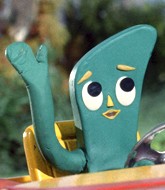
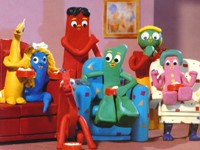
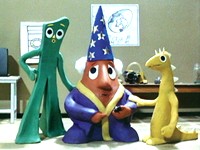
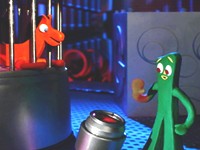
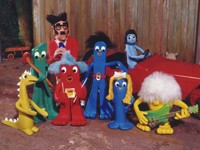
Gumby’s Name, Personality and Voice
What’s in a Name?
Gumby’s name comes from what farmers in Michigan used to call the roads during the rainy season before they were paved. At that time all the roads were dirt, and there was a lot of clay in it. The rains turned the dirt into slippery, muddy clay. Art’s father used to call the mud “gumbo,” as in, “Well, I went out for a drive to the store and got stuck in the gumbo.”
Art’s first film, Gumbasia, got its name when Art combined “gumbo” with “fantasia.”
Now, if you know that Art went to a seminary in Connecticut for a while to become an Episcopal Priest, you also know that he studied Latin for seven years. You also know that Art has a great sense of humor. So he took the word “gumbo” and worked it through all of its forms in Latin as a noun, including the male, female, and diminutive for a child. In Latin, male forms end in “o,” female forms end in “a,” and diminutives end in “ino.” That gives us “Gumbo,” “Gumba,” and “Gumbino.” “Gumby” is the shortened form of “Gumbino.” “Gumbo” became the name for Gumby’s father. “Gumba” became the name for Gumby’s mother.
Following His Heart
Art attributes his ability as a writer to his studies in Latin. “It gave me an interesting command of the English language. I understood the English language a lot better.” Latin helped Art see the many meanings of words, and gave him the ability to express his value-oriented messages with greater clarity at many levels of meaning. As for personality, Gumby has both feet on the ground, but his head is in the clouds. His focus is on doing what is right and good. Because of his faith in following his heart, everything always works out for him in the end, whether that means a triumph, or learning a lesson. You can see this in “Motor Mania,” when he wins the go-cart race against the stuck-up rich kid on the block, and in “Mystic Magic,” when he thinks he can easily get coconut palms to grow in winter, and ends up with palms that grow watermelons instead.
Gumby has been compared to many historic and religious figures around the world. Art was always surprised when he heard about this. “I was astonished when I read that Gumby is a lot like the young boy Krishna; it’s amazing. Of course, Krishna and Jesus, the boy Jesus, they are all the same. It all comes down to unconditional love, I think. Gumby represents the inner soul of everybody, all children and adults. I think it must be because that’s the way people react to him.”
What does Clay Sound Like?
Art Clokey has made a number of timeless archetypes that represent something special for America. What those characters sound like is a large part of their personas. We asked Art about the people whose voices are part of the characters. Who did the first voice of Gumby, and who did the voice after that?
“Well, the first voice of Gumby was a woman. She was the wife of our art director and first artist, Al Eggleston. Her name was Ruth Eggleston. Art and Ruth Clokey brought on Al and Ruth Eggleston as their fist collaborators. Art and Al came up with sets, while Ruth Eggleston, Art and Al provided the voices for most of the characters in the 1956 episodes.
During the 1957 episodes, Dallas McKennon voiced Gumby, and Art continued to do Pokey, Gumbo and various other voices. Dal was an experienced actor who did major voice work for many Disney classics such as Bed Knobs and Broomsticks and Mary Poppins. He later was the voice of Archie and Buz Buzzard, and he starred in The Daniel Boone Show as Cincinatus.
In the early 60’s, Ginny Tyler of Mickey Mouse Club fame did the Gumby voice for a few episodes, while Dal was the voice of Gumby for most of the episodes in the early 60’s. Dick Beals (who was also the voice of the 1960’s Davey) subbed as Gumby’s voice for a few episodes in the mid 60’s. Norma McMillan (the late 60’s/early 70’s Davey) was the voice of Gumby in the late 60’s. She was also the voice of Casper the Friendly Ghost. Dal came back to do the voice of Gumby in the 80’s series and the 90’s movie.
